Initial experiences flagged something unexpectedly special lurking in England’s woefully overdue response to the 3 Series, despite the overly familiar if undeniably handsome design (thematically too similar to the original XF of 2007), patchy dashboard presentation and four-cylinder petrol engines borrowed from Ford.
Our hunch was realised when the XE joined the Mazda MX-5 and Audi Q7 on the 2016 COTY podium, and further reinforced when a 25t beat a BMW 328i, Audi A4 2.0 TFSI quattro, Lexus IS200t and Mercedes C250 Sport in a comparison earlier this year.
Much of what makes the smallest Jag special is the engineering. Enzo Ferrari once said that people paid for the engine and the rest came for free. While not the case here, a brief overview reveals compelling chassis engineering.
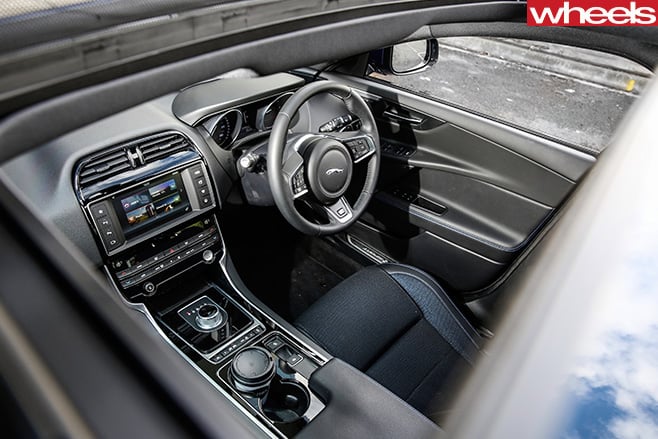
Clearly the Brits have come prepared to fight established German and Japanese rivals.
However, the XE isn’t just about the handling. While clearly focused dynamically, it’s also comfortable, thus forging a link to the famously supple-riding XJs of the 1970s. And that’s without the adaptive damper tech others need to do similar.
Obviously we need to understand how all that translates into living with the car. But we also want to know if the design and dash deserve our criticism, and if reliability and build quality hold up over time.
Initially, we requested and received the popular R-Sport 25t with the 177kW/340Nm Ford turbo-petrol, starting from $68,900. But as this engine is about to be usurped by an all-new Jaguar unit, the switch was kindly made for the hot-off-the-press (and identically priced) 132kW/430Nm 20d Ingenium four-pot turbo-diesel. Not only can the innocuous-sounding 20d manage a 7.8sec dash to 100km/h, it’s rated at a startling 4.2L/100km, though our green example returned (a still very credible) 6.3L/100km in the first month.
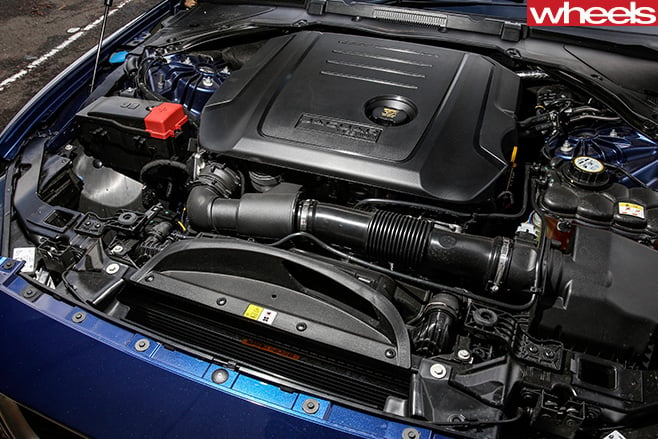
Finished in a beautiful Blue Fire hue, DCY-85W blows the options list out by $11,500 to a considerable $80,400, thanks to a sliding panoramic sunroof, black 19-inch alloys, head-up display and digital radio (appealing options all, at around $1800 a pop, except for the DAB at $540), as well as not-so-essentials such as self-parking ($1600), a powered bootlid ($850), illuminated sills ($770), configurable ambient cabin lighting ($540) and leather upholstery ($2160) instead of the standard R-Sport ‘Luxtec’ vinyl/mesh seat covering.
So our XE arrives with the prospect of being one of the best Jaguars ever. Let’s see what living with this feline is really like.
Petrol alternative
Far from disgraced, the Mondeo-hearted XE 25t petrol with 177kW is a likeably lusty yet sweet performer, and will take some beating when the Ingenium unit takes over next year. Pairing especially well to the eight-speed auto, it melds decent acceleration response with exceptional refinement, particularly at higher revs, backed up by reasonable fuel consumption (averaging 9.5L/100km), sweet handling and a cosseting ride on 18-inch alloys. Little wonder Jaguar pegged this combo as the range bestseller.
The ex-type
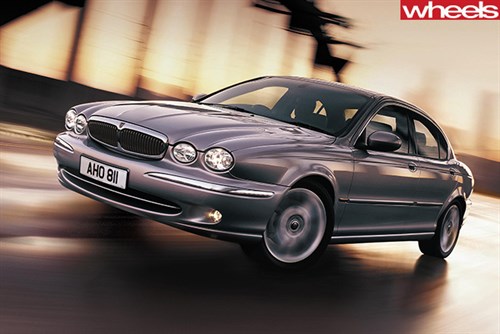
When Ford owned Jaguar, it hoped to crash the BMW 3 Series party with the 2001 X-Type, but miscalculated badly. Looking inside and out like an old-school XJ that had shrunk in the wash, it was dynamically inferior to the athletic (and roomier) Mk2 Mondeo lurking underneath, due to lifeless steering and breathless V6 engines. The base 2.1-litre model was front-drive, the rest AWD. Diesels arrived here from 2008, but Australia missed out on the wagon altogether. Sales stumbled on until 2010.
Update #2
REX or XE? Albury is 260km as the crow flies from Melbourne CBD, or about an hour with our largest regional airliner. The driving distance, though, is 326km, which should take around three and a half hours with one quick pitstop. Logic, therefore, suggests that making like a bird is better.
We’re willing to argue that choosing to fly Jaguar XEpress is best, though. Admittedly, it was my organisational dyslexia that dictated this, but the opportunity to assess the British-built BMW 3 Series-slayer (see Wheels April 2016) in a role it should sashay through proved irresistible. Road trip!
After the usual racket of a cold diesel engine in warm-up, the 2.0d quietens to a distant hum as it thrusts forward with effortless ease, while soaking up the rotten northern-suburban backstreet geography with impunity. Stealthy competence describes both the Jaguar XE’s torquey performance and lush ride quality – and on 19s without adaptive dampers no less.
Into the 110km/h zone, cruise control set at an indicated 116km/h to allow for the margin shortfall according to a free GPS-based speedo app, and everything’s progressing beautifully. This is a truly relaxing environment. Cocooned in the supportive driver’s seat and noticing the lack of wind and road rumble (except on the coarsest bits of bitumen) only enhances the experience. Barely bothering 2000rpm, the Jaguar lopes along.
However, about halfway up the Hume Freeway our XE’s very Ford Sync 2-esque touchscreen multimedia system (though we’re assured they’re totally unrelated)
simply stops streaming music from my smartphone, requiring a USB cable to restore the tunes. This happens again on the way back, but not since. Mark that up as the second fail after the loose boot-sited rear-seat backrest release lever coming loose, as reported last month.
Here’s another irritation. While I’m starting to appreciate the finer details of the interior presentation, such as the racy low driving position, gorgeous steering wheel and stylish upper-fascia layering that integrates dashboard with door cards, the power window switches seem to be located outside your peripheral vision. I inevitably prod the electric door locks instead every single time.
Two months in, these are both minor hiccups in an otherwise commanding grand tourer. The Albury run was completed ahead of schedule, and reversing the journey a few hours later similarly resulted in no aches, pains or fatigue. Just a repeat of the outstanding sub-5L/100km average instant consumption readout.
So we finished well ahead of schedule, with no parking or having to wait at the airport. Travelling MEL to ABX by XE is AOK.
Update #3
THE big city. Is it any place for a loping Jaguar more naturally predisposed to prowling freeways and open highways?
This month there were no long runs to once again stretch our XE 20d’s legs (and fuel mileage), but instead a period of forced captivity within a 10km boundary of the CBD. Short trips only.
Home is within an inner-suburban labyrinth of cobblestone alleyways and sardine-tight backstreets, festooned with speed humps and potholes. Some are more like sinkholes. Great for short-cuts, these rat-runs are nowadays crucial in avoiding the many traffic snarls Melbourne’s long-promised Metro Tunnel and level-crossing removal programs have delivered. It’s commuter warfare out there. So is the Jag a catfish out of water, or is it merely water off the current segment dux’s back?

Sport kills the otherwise prompt idle-stop, but back in Drive we’re grateful for it since it brings some tranquillity in long queues. Not that the engine is noisy.
Furthermore, the XE’s alert steering expertly balances feedback and effort, the brakes are scalpel-sharp, and a taut chassis possesses an astounding ability to iron out the bumps – a feat highlighted by a visiting Mercedes C300 Coupe’s inability to match it despite being on similar rubber.
The ride is crucial in understanding why our R-Sport has clawed its way so high in our estimation. Every XE we’ve driven offers a suppleness that original XJ6 owners might recognise, infused with an athleticism drivers of previous Jaguar sedans wouldn’t. Though the suspension is hardly ground-breaking – double wishbones up front and an integral link at the back – the way the chassis gels is a work of genius.
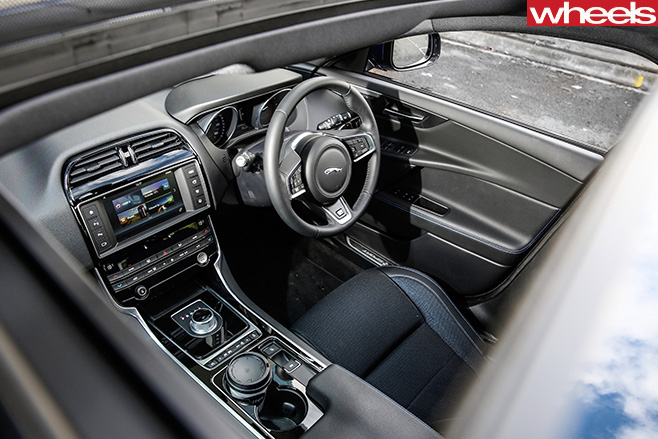
but weeks filled with many boring short trips just could not dull the XE’s lustre.
Completely unfazed by what the inner city can throw at it, there’s plenty of alley-cat guile in this multi-faceted Jag.
Ghost in this machine
British cars have a reputation for dodgy electrics, and having experience with Austin, Morris and Rover to draw on I’m constantly expecting something to stop working… or start of its own accord. This month, the XE finally showed its true heritage by doing just that. Inexplicably, one evening while driving, the sunroof whirred open. It was pretty creepy and a tad inconvenient, being winter and all, but luckily no rain got in. And it has never happened again since. Spooky.
Update #4
Is the Jaguar XE’s rear seat really too tight for two adults, as some critics claim?
The opportunity to find out presented itself recently after loading my Jaguar XE R-Sport 2.0d with three well-nourished mates (all firemen, as it happens) for a 90-minute drive from Melbourne to Airey’s Inlet on the famous Great Ocean Road. Only 10cm separated the shortest (me at 178cm) and the tallest (my bestie Dean).
Getting everyone inside required some calisthenics, but soon we were all snug. “I love the all-enveloping interior; it wraps you up like a Greek grandmother!” Dean quipped, angling for a laugh at my expense. Instinctively, I took that to mean overbearing and smelling of mothballs, but he actually meant that the Jaguar’s cabin is cocooning. Accommodating, comfy, quiet and not at all stuffy.
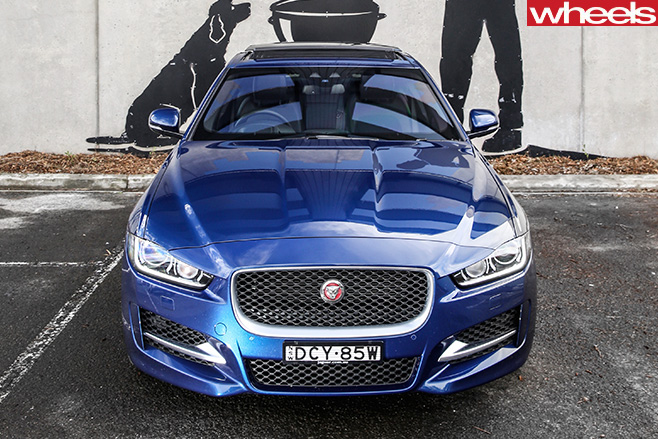
Interesting. Dynamically focussed, the XE clearly isn’t about transporting taller folk for long stints in the back seat, and that’s clear just by looking at it. The cabin is compact. But what we did find out is that, even after 122km, it’s cosy and calm back there, even on 19-inch wheels. That scalps may occasionally be gently caressed by the roof lining shouldn’t be a deal-breaker.
Heading homewards, with Dean at the wheel, I discovered that foot space in the back is limited with the front seat cranked down on its lowest setting – or maybe my mate was finally exacting revenge for something I did in seventh grade. As with his driving position, we go a long way back.

Crikey! He’s spot on. It seems anybody can review cars. I’d better watch my back. I wonder how I’d go handling a fireman’s hose…
Farewell
Those first hero shots of the sedan in the desert, finished in Italian Racing Red and propped on 20-inch Propeller 10-spoke alloys, looked for all the world like the lovechild of the original XF (Jaguar, not Falcon) and VE Commodore SS… which, though boldly macho yet beautifully proportioned, also seemed somewhat derivative. When your rivals include the BMW 3 Series, Mercedes C-Class and Audi A4, a striking first impression is non-negotiable.
Would the new Cat on the block have enough cut-through?

I needn’t have worried. Nearly 12 months later, at the Australian launch, the XE persuasively lured me in with its handsome presence, and then had me completely the moment I turned the first corner. Whether it was the base Mondeo-engined 147kW 20t or the supercharged S with its 250kW 3.0-litre V6, it was clear Jaguar had engineered something superlative. That the ride also possessed a supple lushness no rival still cannot match sealed the deal.
The XE’s inclusion in our long-termer fleet became a priority, particularly after scoring a 2016 Car of the Year award podium finish.
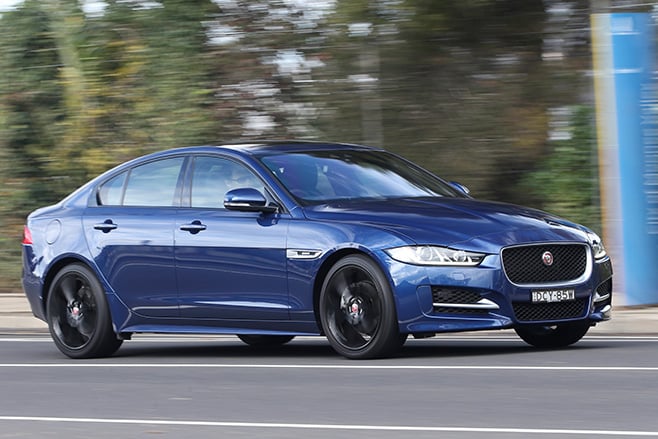
Six months and 6000km later, it’s time to bid farewell to DCY-85W, the Jet Blue 20d R-Sport with Jaguar Land Rover’s lauded all-new Ingenium 132kW/430Nm 2.0-litre four-cylinder turbo-diesel, driving the rear wheels via a ZF eight-speed auto, and sitting on hot 19-inch black alloys. If you’re buying one, make sure to tick the $1800 adaptive damper option to maintain that double-wishbone and multi-link suspension lushness.
Like a broken-hearted fool whose lover has left him, I’m going to spread smack about my XE experience first, starting with that stupid kneecap-cracking dashboard extremity, which necessitates a measured entry and exit strategy for long-legged types akin (apparently) to mounting a horse sidesaddle.
I grew to accept the cheapo instrument dials, which were clearly nicked from the Land Rover Discovery Sport parts bin, mainly because of the extortionately priced ($1770!) head-up display – though you would expect it to actually be visible through polarised sunnies. I became accustomed to peering over my frames like an unimpressed Meryl Streep in The Devil Wears Prada.
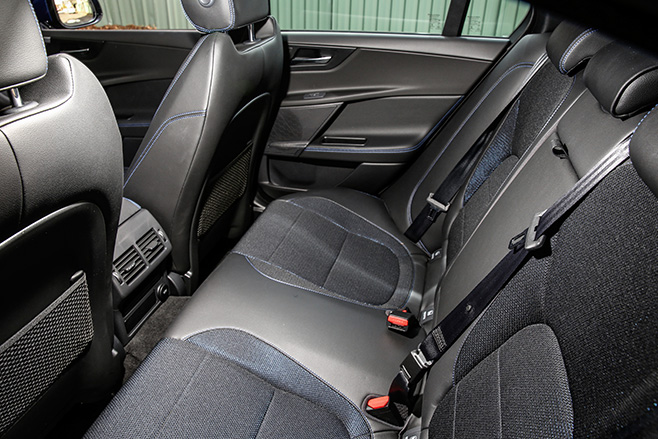
There was the odd mysterious electrical malady, too. Twice during the many otherwise effortless cross-country drives we undertook, the multimedia system refused to stream music and would eventually shut down; one time the sunroof opened and closed by itself; and the cruise control occasionally forgot to maintain the set speed, especially on declines where speed cameras would invariably lurk. Annoying.
Worst of all, though, was the Jaguar’s rear-seatback pull cables, which are held in by flimsy clips that break away all too easily, and also don’t release half the time. I’ve tugged harder than Steamboat Willie to get them to fold. A speedy solution is in order.
But I’m longing to have one last interstate blast in that XE R-Sport, and not just because of the effortless urge from its smooth and economical diesel powertrain, its fluent steering, athletic handling, soothing ride, brilliant seating, superb driving position or rock-solid build quality inside.
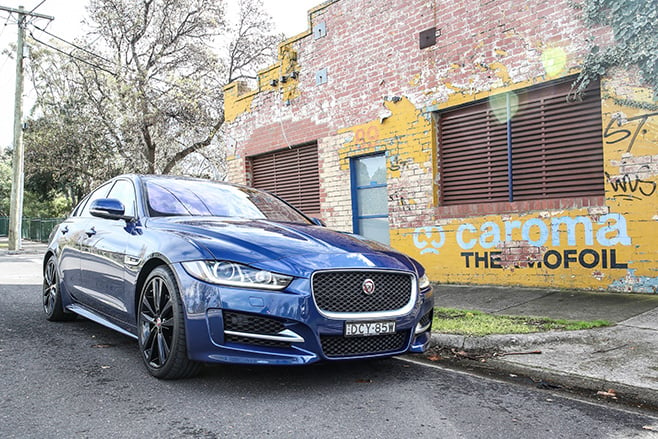
It dawned on me that the XE possesses an X factor that nothing else in its class can match. Is it the exclusivity that comes from going for days without seeing another? Or maybe the smugness knowing how tantalisingly close Jaguar has come to hitting the medium sports luxury sedan brief after only its second attempt.
Whatever it is, this 20d R-Sport deserves to be at the shortlist pointy end for every A4, 3 Series, Q50, IS or C-Class buyer. That 08/09/14 date marks the rebirth of Jaguar cool.





